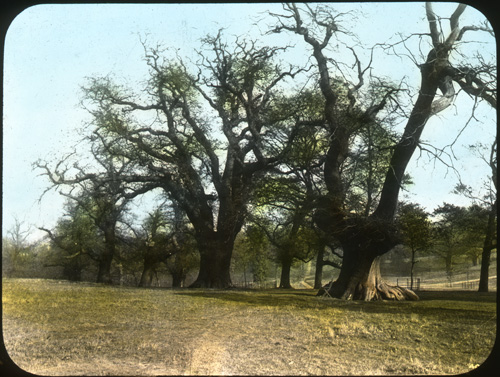Korstian Forestry Education Lantern Slides Now Viewable
From the mid-nineteenth to the mid-twentieth century, lecturers often used glass lantern slides to illustrate their topics. Photographs were copied onto glass plates to make the slides, which would then be used with a projector to cast images onto walls or large screens. First developed in 1849, this process allowed for large groups of people to view photographs at the same time. This new technology was a no-brainer for lecturers. Large audiences now had a visual aid, one that was oftentimes further enhanced through color. Professional colorists hand-tinted the slides, producing colorized photos long before the invention of color film.

Lantern slide depicting a stand of mixed hardwoods and softwoods, Cheat River watershed, West Virginia, 1923.
FHS houses a set of such slides in the Duke University School of Forestry Lantern Slide Collection, a portion of which was recently digitized. These slides were collected by Clarence F. Korstian (1889–1968), a seminal figure in the history of forestry education both in North Carolina and nationwide. Korstian used the slides to accompany lectures during his tenure at Duke University from 1930 to 1959.

Korstian standing in open stand of timber in Craven County, NC, 1927.
Born and raised in Nebraska, Korstian spent the majority of his career in North Carolina. He served two decades with the U.S. Forest Service, about half of that at the Appalachian Forest Experiment Station in Asheville. He left the agency in 1930 to take a job at Duke as both a professor of silviculture and director of the Duke Forest. At Duke, Korstian organized a graduate school of forestry and served as the school’s first dean when it opened in the fall of 1938. He was instrumental in developing one of the nation's leading forestry programs during his tenure, while also managing and expanding Duke Forest.

Duke Forest vehicle traveling on bridge over New Hope Creek in Durham, NC, 1930s.
The lantern slides Korstian collected to illustrate his forestry lectures come from at least 36 different states and several countries. Some of the photographs were taken by Korstian during his time with the Forest Service. The collection also includes photos from a trip he took to Europe to visit forestry schools in Germany, Switzerland, and France in the summer of 1932. The majority of slides in the collection are hand-colored, and as a whole they provide a unique look at forestry practices of the time as well as photographic technology.

Dr. Hans Mayer-Wegelin, Forstassessor Petri, and Prof. Joshua Alban Cope on forest road in Bramwald Staatsoberforsterei. Hann-Munden, Germany, 1932.
By the 1940s, 35mm Kodachrome slides began to take over as the preferred method for publicly showcasing photographs. Lantern slide use all but disappeared by the late 1950s. This was also around the same time that Korstian’s own career was winding down. He relinquished the deanship in 1957, and fully retired two years later. Following his retirement in 1959, one of the major divisions of Duke Forest was named in his honor.
Over 100 of the 900 slides in the collection have so far been digitized and can now be accessed online via the FHS image database. You can view more selections from the collection below, and see the collection’s finding aid for additional information. To learn more about Korstian, read the oral history interview Clarence F. Korstian: Forty Years of Forestry conducted by Elwood Maunder in 1959.

Second growth oaks, damaged at the base by fires. Pisgah National Forest, 1927.

Steam skidder in a gum swamp, Dismal Swamp area, NC, 1922.

Kudzu vines planted to control erosion, Tennessee, 1930.

Chestnut trees at Greenwich Park, England.

Virgin forest, chiefly spruce, at high elevation with rhododendron undergrowth, NC, 1900.

